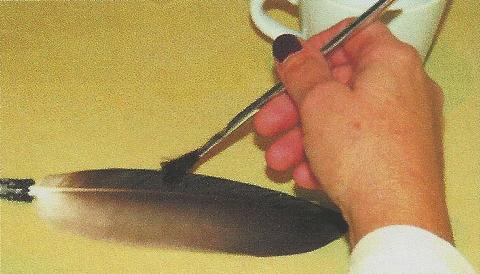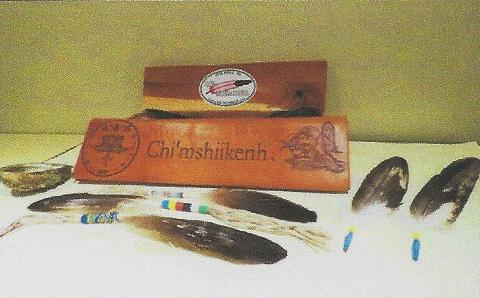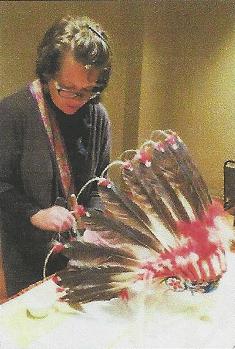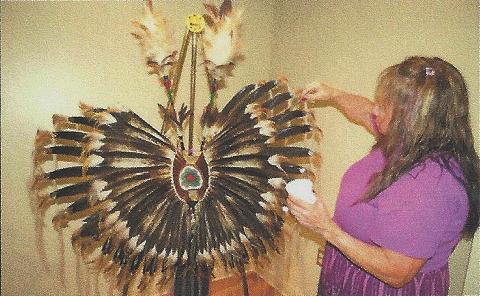 |
Canku Ota
|
 |
|
(Many Paths)
|
||
|
An Online Newsletter
Celebrating Native America
|
||
|
December 2016 - Volume
14 Number 12
|
||
|
|
||
|
Community comes Together
At 18th Annual Eagle Feather Cleansing, Honoring And Feast
|
||
|
by Joseph V. Sowmick
- Photojournalist. Saginaw Chippewa Tribal Observer
|
||
|
credits: All photos by
Joseph V. Sowmick
|
On Oct. 19-21, the Ziibiwing Center of Anishinabe Culture & Lifeways hosted another cultural event where the community came together for their 18th annual eagle feather cleansing, honoring and feast. The more than 500 eagle feathers displayed are an example of honoring the life of the Anishinabe people, past and present, and an honoring of the life and the spirit of the eagle. This gives blessings and strength to Anishinabe people. Anishinaabe kwe, Ziibiwing staff and community members participated in the annual eagle feather cleansing on Oct. 19. Curator William Johnson said that Ziibiwing understands and accepts the physical and spiritual responsibility in maintaining the sacred and ceremonial collection. "(The cleansing) is a lot of work that we take seriously, and we are highly honored to have the Saginaw Chippewa eagle staff with us for the first time," Johnson said. "The Eagle feathers in the sacred and ceremonial collection are well cared for and it shows. Many community members and young people brought their Eagle feathers in for cleansing and for that we're grateful." Kent Jackson, elder and weekaun (spiritual leader) of the Anishinabe Ogitchedaw Veterans Warrior Society, was a part of the three-day teaching and he shared some of what he has learned from his elders at the Oct. 21 feast. "It was shared a long time ago that this bird saved Anishinaabe people when it found the Creator's instruction and brought it back down to us," Jackson said. "The eagle sees great distances and knows the struggles we have, shares our pain with Gitchi Manitou (Great Spirit) and carries the solution back through the spirit contained in the feathers. The eagle sees the smoke rising (and) sacred fires lit all across Indian Country and reports back to the Creator every day of what's happening on Mother Earth and Anishinaabe people."
Anishinabe people need to attend these ceremonies themselves, Jackson said. Until you actually come out and participate, that's when you get the full power of what the teachings and feathers are about. "Each one of these feathers has a story that needs to be told and shared," Jackson said. Anishinaabe kwe Maria Colberg, whose spirit name is Angel Eyes, participated all three days. "It was a great honor to bring these spiritual items out of the collection and I find these feathers want to be social and to do the work the Creator intended," Colberg said. "In preserving, cleaning and honoring them, the whole ceremony has been beautifully peaceful." This year's ceremony marked the first time the SCIT eagle staff came in for cleansing. "One thing I tried to do while cleaning the feather for the SCIT Eagle Staff is to remember the spirit that comes through and the comfort it gives in all the locations and ceremonies it is used in," Colberg said. "Many people don't get the blessing to be this close to such a spiritual gift for the people and I take reverence and extreme care in this responsibility. The honor to do this special cleansing is a high honor because of what the staff represents to all the people."
Chief Frank Cloutier brought eagle feather plumes he donated that will be cleaned and incorporated into the staff, Colberg said. Victoria Voges is a Potawatomi Anishinaabe kwe who traveled from Okemos to participate. "The experience itself of just being in this room, and the history it represents, is beyond words," Voges said. "Feathers that are taken out in the public or used in healing need a cleaning, just like any of the other spiritual items used in ceremony. These feathers are still alive because of the spirit that comes through them. If the feathers aren't cleansed, the spirit within has a harder time coming through to provide the healing touch they offer us freely." |
|||||||||||||
|
|
|
|
||
|
|
||
| Canku Ota is a free Newsletter celebrating Native America, its traditions and accomplishments . We do not provide subscriber or visitor names to anyone. Some articles presented in Canku Ota may contain copyright material. We have received appropriate permissions for republishing any articles. Material appearing here is distributed without profit or monetary gain to those who have expressed an interest. This is in accordance with Title 17 U.S.C. Section 107. | ||
|
Canku Ota is a copyright ©
2000 - 2016 of Vicki Williams Barry and Paul Barry.
|
||
 |
 |
|
|
The "Canku
Ota - A Newsletter Celebrating Native America" web site and
its design is the
|
||
|
Copyright ©
1999 - 2016 of Paul C. Barry.
|
||
|
All Rights Reserved.
|
||




